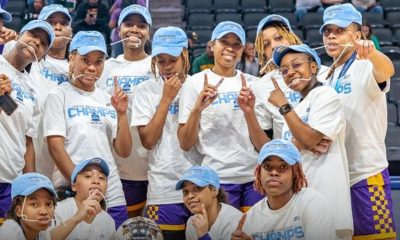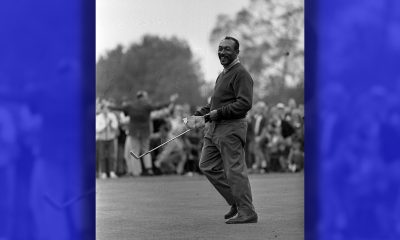Black History
Three Minneapolis women who broke cheerleading color barriers
MINNESOTA SPOKESMAN-RECORDER — Prior to 1923, cheerleading had been an exclusively White male activity. That year, the University of Minnesota (U of M) became the first school in America to allow female cheerleaders. It remained an all-White activity there, however, until Dana Purdue Williams became the first African American cheerleader at the U of M in 1975.
By Ken Foxworth
Two trailblazing cheerleaders were recognized at St. Peter’s Church in Minneapolis: (l-r) Harriet Bowman Solomon, Gwendolyn Morrow Fraction; Rev. Carla Mitchell, pastor of St. Peter’s; and former Minneapolis Public Schools.superintendent Dr. Carolyn Johnson.
Few people realize that not only did women athletes cheerleading at sporting events originate right here in Minnesota, but also several strong African American women made Black history here by breaking the cheerleading color barrier.
Prior to 1923, cheerleading had been an exclusively White male activity. That year, the University of Minnesota (U of M) became the first school in America to allow female cheerleaders. It remained an all-White activity there, however, until Dana Purdue Williams became the first African American cheerleader at the U of M in 1975.
Below are Williams’ story and two other earlier cheerleading firsts that inspired her to pursue her own dream.
Gwendolyn Morrow Fraction
A 1950 Minneapolis North High School graduate, Fraction became in 1949 the first African American cheerleader in the state of Minnesota. Upon graduation, she worked for Northwestern Bell and in banking, insurance, and accounting. At age 85, Fraction still volunteers in the community and is known for her beautiful voice.
Following in her mother’s footsteps, Fraction’s daughter Cindy became a cheerleader for Washburn High School, graduated in 1983, and is now program director of research at the University of St. Thomas.
Harriet Bowman Solomon
A 1951 Central High School graduate, Solomon watched her brothers play football and other extracurricular activities. Her brother Earl Wesley Bowman attended college on a football scholarship, played baseball at a major university, played semi-pro football, and became the first African American president of Minneapolis Community College. Her other brother, Henry Bowman, was a member of the Tuskegee Airmen as well as a Big 10 regional player.
Harriet wanted to establish her own legacy and accomplished this through cheerleading. She was the first African American cheerleader at Minneapolis Central High in 1950 and later worked for Northwestern Bell. After retirement in 1995, she volunteered at McRae Park.
Edward C. Soloman Park near Lake Nokomis in Minneapolis was named after Harriet’s husband for his outstanding contribution to the Minneapolis park system as a board member and a volunteer at McRae Park
Dana Purdue Williams
This 1975 Washburn High School graduate who went on to become the U of M’s first Black cheerleader says that at an early age she watched her mother, Harriet Bowman Solomon, cheerleading in the kitchen, living room, or anywhere else where she had space and a chance. She also watched her best friend Gwendolyn Morrow Fraction doing the same, all while having fun.

MSR News Online/MSR News Online Dana Purdue Williams as a U of M cheerleader in 1975
Williams recalls her mother enrolling her in ballet classes at the tender age of six. At age 10 she attended the Minnesota Dance Theater children’s workshop, where she became an apprentice and mastered the program by age 15.
She thought all of that experience and her mom’s example put her in position to make Minnesota Gopher history. “When I saw the 1975 tryout poster for the University of Minnesota cheerleading squad,” Williams says, “I truly knew that I was ready to go complete. I saw myself being a Gopher cheerleader at the age of seven. I planned this all my life, and no one was going to stop me from pursuing my dream!”
As Williams took her inspiration from predecessors Fraction and Solomon, so did she take their career advice, becoming a flight attendant for 40 years at Delta/Northwest Orient Airlines. She now works as an ambassador for Delta Airlines, visiting their headquarters in Atlanta, GA to inspire and motivate future flight attendants to be all that they can be for the customers and the company.
Williams has also has been giving back to her community through the years by helping young inner-city girls and working with football camps at McRae Park in South Minneapolis.
Cheerleading history’s importance
The most important thing in sports is not just the games and their players — it’s the fans and their enthusiasm that makes the games so wonderful. And who is it that gets the fans yelling themselves raw cheering on their teams to victory? That’s what the cheerleaders do, though rarely do they get credited for their athletic contributions to the sports world.
Not so long ago, cheerleading was the only opportunity for girls to be seen and heard as athletes at their schools, colleges and universities. Before the Title IX federal civil rights law came into effect in 1973, girls did not have the same opportunities as boys to develop their skills in sports. The only thing they could do was to go out on that field and cheer on their team.
Fraction, Solomon and Williams all made important strides for Black women athletes between 1949 and 1975. Thanks to them and many others like them, girls around the Twin Cities can now aspire not only to become cheerleaders in high school and their respective universities and colleges. Now they can aspire to compete as athletes in any sport that captures their dreams.
This article originally appeared in the Minnesota Spokesman-Recorder.
Activism
Oakland Post: Week of April 17 – 23, 2024
The printed Weekly Edition of the Oakland Post: Week of April 17 – 23, 2024

To enlarge your view of this issue, use the slider, magnifying glass icon or full page icon in the lower right corner of the browser window. ![]()
Black History
Matthew Henson: Explorer Extraordinaire
Matthew Henson, a trailblazing explorer who overcame countless obstacles to leave an incredible mark on history. Born on August 8, 1866, in Charles County, Maryland, his journey is a testament to the power of determination and the spirit of adventure.

By Tamara Shiloh
Matthew Henson, a trailblazing explorer who overcame countless obstacles to leave an incredible mark on history. Born on August 8, 1866, in Charles County, Maryland, his journey is a testament to the power of determination and the spirit of adventure.
Henson’s life began amidst the backdrop of post-Civil War America, where opportunities for African Americans were scarce. From a young age, he possessed an insatiable curiosity about the world beyond his small town. At the age of 12, he embarked on a journey that would change the course of his life forever when he joined a merchant ship as a cabin boy.
His most famous expedition was his journey to the Arctic with renowned explorer Robert E. Peary. In 1887, Henson joined Peary’s crew as a seaman and quickly proved himself to be invaluable with his skills as a navigator and craftsman. Over the course of several expeditions, Matthew endured extreme cold, treacherous terrain, and grueling conditions as he and Peary sought to reach the elusive North Pole.
In 1908–09, Peary set out on his eighth attempt to reach the North Pole. It was a big expedition, with Peary planning to leave supplies along the way. When he and Henson boarded their ship, the Roosevelt, leaving Greenland on August 18, 1909, they were joined by a large group. This included 22 Inuit men, 17 Inuit women, 10 children, 246 dogs, 70 tons of whale meat, blubber from 50 walruses, hunting gear, and tons of coal.
In February, Henson and Peary left their anchored ship at Ellesmere Island’s Cape Sheridan, along with the Inuit men and 130 dogs. They worked together to set up a trail and supplies along the way to the Pole.
Peary picked Henson and four Inuit people to join him in the final push to the Pole. However, before they reached their destination, Peary couldn’t walk anymore and had to ride in a dog sled. He sent Henson ahead to scout the way. In a later interview with a newspaper, Henson recalled being in the lead and realizing they had gone too far. The group turned back, and Henson noticed his footprints helped guide them to their destination. At that location, Henson planted the American flag.
Henson’s legacy extends far beyond his expeditions to the Arctic. He shattered racial barriers in the world of exploration and inspired countless individuals, regardless of race, to dream big and pursue their passions. In 1937, he was finally recognized for his achievements when he was inducted into The Explorers Club, an organization dedicated to promoting scientific exploration and field research.
Matthew Henson died in the Bronx, New York, on March 9, 1955, at the age of 88.
Art
Marin County: A Snapshot of California’s Black History Is on Display
The Marin County Office of Education, located at 1111 Las Gallinas Ave in San Rafael, will host the extraordinary exhibit, “The Legacy of Marin City: A California Black History Story (1942-1960),” from Feb. 1 to May 31, 2024. The interactive, historical, and immersive exhibit featuring memorabilia from Black shipyard workers who migrated from the South to the West Coast to work at the Marinship shipyard will provide an enriching experience for students and school staff. Community organizations will also be invited to tour the exhibit.

By Post Staff
The Marin County Office of Education, located at 1111 Las Gallinas Ave in San Rafael, will host the extraordinary exhibit, “The Legacy of Marin City: A California Black History Story (1942-1960),” from Feb. 1 to May 31, 2024.
The interactive, historical, and immersive exhibit featuring memorabilia from Black shipyard workers who migrated from the South to the West Coast to work at the Marinship shipyard will provide an enriching experience for students and school staff. Community organizations will also be invited to tour the exhibit.
All will have the opportunity to visit and be guided by its curator Felecia Gaston.
The exhibit will include photographs, articles and artifacts about the Black experience in Marin City from 1942 to 1960 from the Felecia Gaston Collection, the Anne T. Kent California Room Collection, The Ruth Marion and Pirkle Jones Collection, The Bancroft Library, and the Daniel Ruark Collection.
It also features contemporary original artwork by Chuck D of the Rock and Roll Hall of Fame group Public Enemy, clay sculptures by San Francisco-based artist Kaytea Petro, and art pieces made by Marin City youth in collaboration with Lynn Sondag, Associate Professor of Art at Dominican University of California.
The exhibit explores how Marin City residents endured housing inequities over the years and captures the history of plans to remove Black residents from the area after World War II. Throughout, it embodies the spirit of survival and endurance that emboldened the people who made Marin City home.
Felecia Gaston is the author of the commemorative book, ‘A Brand New Start…This is Home: The Story of World War II Marinship and the Legacy of Marin City.’ Thanks to the generous contribution of benefactors, a set of Felecia’s book will be placed in every public elementary, middle, and high school library in Marin.
In addition, educators and librarians at each school will have the opportunity to engage with Felecia in a review of best practices for utilizing the valuable primary sources within the book.
“Our goal is to provide students with the opportunity to learn from these significant and historical contributions to Marin County, California, and the United States,” said John Carroll, Marin County Superintendent of Schools.
“By engaging with Felecia’s book and then visiting the exhibit, students will be able to further connect their knowledge and gain a deeper understanding of this significant historical period,” Carroll continued.
Felecia Gaston adds, “The Marin County Office of Education’s decision to bring the Marin City Historical Traveling Exhibit and publication, ‘A Brand New Start…This is Home’ to young students is intentional and plays a substantial role in the educational world. It is imperative that our community knows the contributions of Marin City Black residents to Marin County. Our youth are best placed to lead this transformation.”
The Marin County Office of Education will host an Open House Reception of the exhibit’s debut on Feb. 1 from 4 p.m. – 6 p.m.. All school staff, educators, librarians, and community members are encouraged to attend to preview the exhibit and connect with Felecia Gaston. To contact Gaston, email MarinCityLegacy@marinschools.org
-

 Activism4 weeks ago
Activism4 weeks agoOakland Post: Week of March 27 – April 2, 2024
-

 #NNPA BlackPress4 weeks ago
#NNPA BlackPress4 weeks agoCOMMENTARY: D.C. Crime Bill Fails to Address Root Causes of Violence and Incarceration
-

 #NNPA BlackPress4 weeks ago
#NNPA BlackPress4 weeks agoFrom Raids to Revelations: The Dark Turn in Sean ‘Diddy’ Combs’ Saga
-

 #NNPA BlackPress4 weeks ago
#NNPA BlackPress4 weeks agoCOMMENTARY: Lady Day and The Lights!
-

 #NNPA BlackPress4 weeks ago
#NNPA BlackPress4 weeks agoMayor, City Council President React to May 31 Closing of Birmingham-Southern College
-

 #NNPA BlackPress4 weeks ago
#NNPA BlackPress4 weeks agoBaltimore Key Bridge Catastrophe: A City’s Heartbreak and a Nation’s Alarm
-

 #NNPA BlackPress4 weeks ago
#NNPA BlackPress4 weeks agoBaltimore’s Key Bridge Struck by Ship, Collapses into Water
-

 #NNPA BlackPress4 weeks ago
#NNPA BlackPress4 weeks agoBeloved Actor and Activist Louis Cameron Gossett Jr. Dies at 87

















































